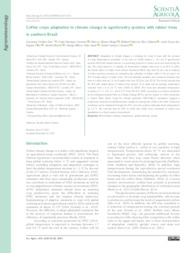Coffee crops adaptation to climate change in agroforestry systems with rubber trees in southern Brazil.
Coffee crops adaptation to climate change in agroforestry systems with rubber trees in southern Brazil.
Author(s): ZARO, G. C.; CARAMORI, P. H.; WREGE, M. S.; CALDANA, N. F. da S.; VIRGENS FILHO, J. S. das; MORAIS, H.; YADA JUNIOR, G. M.; CARAMORI, D. C.
Summary: ABSTRACT: Adaptation to climate change is a strategy for crops to cope with the scenario of rising temperatures worldwide. In the case of Coffea arabica L., the use of agroforestry systems (AFS) with woody species is a promising practice to reduce excessive heat during the day. This study aimed to 1) evaluate air temperature changes that occur in an AFS of coffee and double alleys of rubber trees (Hevea brasiliensis Müell. Arg.) and 2) carry out an analysis of future warming scenarios by comparing the cultivation of Arabic coffee in full sun and in an AFS of double alleys of rubber trees. The microclimatic variables were measured between two rows of coffee trees at 1.0 m of height from June 2016 to June 2018. The results indicate that the AFS with double alleys of rubber trees spaced 16 m apart had an average temperature reduction from 1.4 to 2.5 °C from 10h00 to 16h00. The study also simulated temperature increases of 1.7, 2.6, 3.1, and 4.8 °C from 2018 to 2099, according to scenarios predicted by the Intergovernmental Panel on Climate Change (IPCC), and the impact in coffee production in Paraná State, Brazil. Using the climatic generator PGECLIMA_R, simulations suggest a progressive reduction of traditional areas suitable for open-grown coffee in the state. Production conditions can be maintained through the AFS, since the systems attenuate mean temperatures by 1-2 °C. We conclude that the AFS of coffee and rubber trees contribute to coffee crop adaptations to a future warmer environment.
Publication year: 2022
Types of publication: Journal article
Unit: Embrapa Forestry
Observation
Some of Embrapa's publications are published as ePub files. To read them, use or download one of the following free software options to your computer or mobile device. Android: Google Play Books; IOS: iBooks; Windows and Linux: Calibre.
Access other publications
Access the Agricultural Research Database (BDPA) to consult Embrapa's full library collection and records.
Visit Embrapa Bookstore to purchase books and other publications sold by Embrapa.

